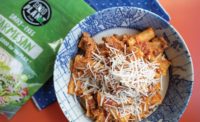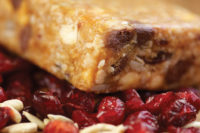Specialty Fibers Function in Formulas




Nutritional and Functional Benefits of Fibers
June 2011 Prepared Foods – About 35% of Americans are obese, while 70% are overweight. Of children, 20% are obese and one third overweight. Many Americans consume more calories than they expend, creating an “energy imbalance” or “energy gap.” This energy gap is the principal cause of America’s obesity epidemic. Reduced caloric consumption and increased physical activity are crucial to arrest obesity in the U.S. The goal of the “Let’s Move!” campaign, together with the Healthy Weight Commitment Foundation (HWCF), is to reduce calories by 5.5 trillion per year, or by 100 calories per person, per day. HWCF says, “The way to achieve this is by introducing lower-calorie foods, changing product formulations and reducing portion sizes.”
According to Ramakanth Jonnala, project leader, R&D, and Jit Ang, executive vice president, R&D, International Fiber Corporation, the use of non-caloric and low-caloric, fiber-based ingredients in different food systems is a means to accomplishing these goals. This topic, “Development of Reduced-calorie Foods Using Non-caloric Ingredients,” was addressed in a Prepared Foods’ R&D Seminar-Chicago.
Dietary fiber includes polysaccharides, oligosaccharides, lignin and associated plant substances. Traditionally, dietary fibers are classified into two major categories, either water-soluble or -insoluble. Most of nature’s fibers are insoluble and cellulosic in nature.
Jonnala and Ang explained that insoluble fibers increase the bulk of foods, while slowing discharge of food out of the stomach. This results in reduced hunger sensation, therefore prolonging the feeling of satiety. Insoluble fiber also provides bulk to the contents of the small intestine and helps remove undesirable byproducts of the metabolism process. Peristaltic movement is improved, as insoluble fiber reduces passage time through the small intestine. Insoluble fibers enter the large intestine undigested, because the human body lacks an enzyme system to hydrolyze them. This increases the volume and softness of the stool, achieving a better bowel movement.
Soluble fibers, they go on to say, are, in the traditional sense, gums. Soluble fibers are normally associated with physiological benefits of fiber consumption.
High-fiber foods tend to have fewer calories than low-fiber foods. Since insoluble fibers are undigested in the human gut, they contribute zero calories to the diet. In foods, the physical properties that affect the functionality of fibers are color, odor, flavor, particle size or chain length, water or oil retention, and density. Depending on the food product, the list of functions fiber ingredients provide includes anti-caking, aeration, syneresis control, thickening, bulking, aiding in extrusion, controlling browning, extending shelflife and stabilizing—as well as adding fiber and relatively few calories to the diet.
In bakery applications, fiber improves volume; increases pliability; enhances texture; extends shelflife; and promotes better dough absorption. In white breads, tortillas and pound cakes, cellulose fiber can help achieve a product with 25% fewer calories than a standard product. In whole-grain breads, fiber ingredients add volume and enhance texture; allow aeration and gas retention; promote better dough handling, at certain levels; improve yield; reduce calories; and extend shelflife. In case of extruded products, such as pasta, cellulose increases the rate of extrusion; the smaller the particle size of fiber, the higher the rate of extrusion. Effects of cellulose on fish or chicken coated with batter were tested for fat absorption, after being fried in different oils or shortenings; fibers help reduce fat pickup and, thus, reduce calories. In general, proprietary cellulose in fried foods improves overall appearance; prevents separation of the matrix from coating after frying; reduces “blow-outs;” imparts more even color; and reduces non-enzymatic browning. Other benefits are lighter color and improved cling properties of the batter.
Fiber ingredients are useful, when developing low-calorie foods. Different types of vegetable- and grain-based fibers may function differently in various foods. Fibers help to increase bulk in foods, as well as help reduce serving sizes and calories.
“Development of Reduced-calorie Foods Using Non-caloric Ingredients,” Ramakanth Jonnala, project leader, R&D, rjonnala@ifcfiber.com; and Jit Ang, executive vice president, R&D, jang@ifcfiber.com, International Fiber Corporation, www.ifcfiber.com
--Summary by Elizabeth Mannie, Contributing Editor
Studies Support Prebiotic Fiber Benefits
Chicory-based, prebiotic fiber ingredients, like inulin and oligofructose, add functional and nutritional value to food products and supplements. Inulin is manufactured by a hot-water extraction from chicory roots. If inulin is partially hydrolyzed enzymatically, then oligofructose is produced. “Chain lengths of the fibers play important roles in the fibers’ physical characteristics, such as texturizing properties, solubility, sweetness, stability and appearance,” stated Joseph O’Neill, executive vice president, sales and marketing, BENEO Inc., in a Prepared Foods’ R&D Seminar-Chicago, “Connecting Nutrition and Health with Prebiotic Fiber.”
Inulin can replace fat in water-based systems and acts as a texturizer in foods. Oligofructose can replace sugar and adds mild sweetness, with synergistic sweetening effects. Combining high-intensity sweeteners with oligofructose can produce a sweetness profile similar to sugar. Oligofructose also adds body to products, is highly soluble and has a clean taste. Thus, with no compromise on taste, reduced-sugar claims can be made, in addition to a prebiotic effect, said O’Neill.
Inulin and oligofructose are fibers considered to be prebiotic. Prebiotics are non-digestible food ingredients that selectively stimulate the growth and/or activity of one or a limited number of bacteria in the colon—which improve host health. “There are three criteria for a fiber to fulfill, before it can be classified as a prebiotic. These include non-digestibility, fermentation by intestinal microflora, and selective stimulation of the growth and/or activity of intestinal bacteria associated with health and well-being,” O’Neill went on to say. Oligofructose and inulin have been shown to selectively increase Bifidobacteria, and this has been repeatedly confirmed in human intervention studies, starting at a dose of 5g/day.
For example, in one study where subjects consumed 15g/day of oligofructose, Bifidobacteria increased from 17- 82% of total intestinal flora in subjects over a period of 14 days. When the same amount of inulin was consumed, it resulted in an increase of Bifidobacteria of 20-73%. Consumption of the fibers also resulted in increased stool weight and stool frequency, better regularity, constipation relief and improved intestinal transit.
“In addition to the intestinal benefits gained from consumption of prebiotic fibers, specific short and long chains of oligofructose and inulin fibers from chicory have also shown ability to significantly improve calcium absorption and increase bone mineral density and bone strength,” added O’Neill. These results were shown in a randomized, double-blind, case-controlled intervention trial of 100 adolescent girls and boys aged 9-12 years, where they had calcium intakes of 900-1,000mg/day and 8g/day of oligofructose-enriched inulin. (See chart “Breakthrough in Bone Health.”)
In the U.S., fiber, as a concept, is easily accepted and understood by consumers. Products with fiber and digestive health claims are one of the fastest growing categories in the U.S., according to data from The Nielsen Company and Information Resources Inc.
In summary, inulin and oligofructose are great-tasting, natural fibers—and not just ordinary fiber, either. They offer a wide range of technical functionality, including sugar and fat replacement, bulking effects and binding characteristics. In addition, they offer exciting nutritional benefits of fiber enrichment, digestive health and bone health. Addition of these ingredients can help meet the needs of today’s health-conscious consumers.
“Connecting Nutrition and Health with Prebiotic Fibers,” Joseph O’Neill, executive vice president, sales and marketing, BENEO Inc., joneill@orafti-us.com, www.orafti.com
—Summary by Elizabeth Mannie, Contributing Editor
Resistant Wheat Starch as Dietary Fiber
Resistant starch is typically defined as the sum of starch and products of starch degradation that are not absorbed in the small intestine of healthy individuals. Resistant starch is recognized as dietary fiber by the American Association of Cereal Chemists, the Institute of Medicine, the European Food Safety Authority and the Codex. Four basic types of resistant starch exist. RS1 is physically inaccessible starch that is derived from partially milled seeds and legumes. RS2 is a granular starch that is native, uncooked potato and high-amylose maize starch. RS3 is a non-granular, retrograded amylose that is a cooked and cooled, non-waxy or de-branched starch. And, finally, RS4 is a chemically modified starch, cross-linked or hydroxypropylated.
“Commercially available RS2 and RS4 resistant starch, mixed in equal parts in water, had a positive effect on blood sugar and glycemic response,” explained Kyungsoo Woo, Ph.D. (formerly principal scientist, MGP Ingredients Inc., now with Nestle R&D), in his presentation, “Increasing Dietary Fiber in Foods Using Resistant Wheat Starch,” at a recent Prepared Foods’ R&D Seminar-East.
RS4 has been shown to increase the amount of Bifidobacteriaand decrease E.coliin the intestinal tract. Both RS2 and RS4 have potential as prebiotic starches, but RS4 wheat starch has higher bifidogenic effect (>300%) in the increase in bifidobacterial numbers. It also has a more immediate effect (2-4 days) than RS2, which takes more than a week. A diet containing 33g of RS4 wheat starch is well-tolerated by human subjects. A hamster study showed a lower body weight after a diet of RS4 wheat starch. There is also evidence that diets with cross-linked RS4 improved calcium absorption by approximately 40%, in a high-calcium diet.
Woo also explained, “The functional properties of fibers include water-holding capacity, freeze-thaw stability, increased dough strength and improved shelflife, while also reducing calories and increasing dietary fiber.” Applications for fortifying with RS4 wheat starch include wheat bread, muffins, buns, pasta, noodles, tortillas, pizza dough, breakfast cereal, cookies, waffles, bagels, biscuits, snacks, brownies, pretzels and crackers. Label claims for “good” or “excellent” source of fiber and “reduced-calorie” are easily achieved using resistant starches.
When used for flour replacement RS4 wheat starch has lower water-binding capacity (0.7g water/g) than conventional fiber. It is easily incorporated into formulations, with virtually no other changes necessary, and is a natural fit for flour-based products. RS4 wheat starch also enhances sensory properties of foods, with its white color and invisible fiber source. It promotes a smooth, non-gritty texture; improves crispiness and shelflife; and has a neutral taste, Woo added.
In addition, dietary fibers replace fat; insoluble fiber is dispersible and stable in cold water. Fiber improves emulsion stability and can act as a carrier for micronutrients, like minerals, nutritional additives and flavors. In puff pastry, dietary fiber reduces fat and calories and increases crispiness and flakiness, while helping to evenly distribute the remaining fat. It also contributes to microwave-induced crispiness, often important for frozen products.
“Increasing Dietary Fiber in Foods Using Resistant Wheat Starch,” Kyungsoo Woo, Ph.D., formerly principal scientist, MGP Ingredients Inc., now with Nestle R&D, www.mgpingredients.com
—Summary by Elizabeth Mannie, Contributing Editor
Mechanisms of Probiotics and Prebiotics
A good balance of bacteria is essential for optimum digestive health. Connie Sindelar, probiotic format development manager, Danisco, in a Prepared Foods’ R&D Seminar-East presentation titled, “Probiotics and Prebiotics for Digestive Health,” explained the human intestine is the largest immune response organ, responsible for approximately 70% of the system. In the gut, the food is broken down to small components. Nutrients, water and other small molecules are absorbed from the intestine into the bloodstream. But, other components, including bacteria, may affect the environment and the intestinal microflora negatively or positively.
The common Western diet plays a significant role in several intestinal complications, such as constipation, diverticulitis, gastritis and many more conditions. This is due, in part, to elimination of many naturally occurring fibers in foods, to be replaced by components, such as refined white wheat flour. However, digestive health is one of the top 10 key trends and one of four top health issues affecting consumers personally, noted Sindelar.
The exact mechanisms of how probiotic bacteria confer health benefits to their host are still to be fully elucidated. One proposal is that these microorganisms survive through the GI tract, adhere to mucosal surfaces and prevent adherence of harmful microbes.
When it comes to adding probiotics to food, critical parameters include product pH, water activity, temperature, storage time, oxygen content, metabolic carbohydrates and consumer preparation parameters.
Each probiotic strain is unique, with some strains inherently more stable than others. Strains should be selected based on the application, for which suppliers may have suggestions. The primary application for probiotics has traditionally been in dairy foods, and these have been well-researched. But, probiotic launches in non-dairy foods have been steadily increasing.
“Prebiotics,” Sindelar adds, “are non-digestible food ingredients that beneficially affect the host by selectively stimulating the growth and/or activity of one or a limited number of bacteria in the colon—thus improving host health.” The definition has been further developed. Now, in order to qualify as a prebiotic, a compound must resist gastric acidity, hydrolysis by mammalian enzymes and gastrointestinal absorption; be fermented by the gastrointestinal microflora; and stimulate selectively the growth and activity of bacteria associated with health and well-being. In one study, cancer risk was reduced in a rat model, possibly by promoting production of certain gut peptides. Additionally, healthy male volunteers showed reduction in triglycerides during consumption of inulin/FOS.
Prebiotics have been successfully added to dairy, confections, bakery, beverages, pasta and sauces. Considerations when formulating are solubility; taste and texture; toleration; dose required; stability through processing temperatures and pH; storage conditions; and shelflife. pf
“Probiotics and Prebiotics for Digestive Health,” Connie Sindelar, probiotic format development manager, Danisco, Connie.sindelar@danisco.com, www.danisco.com
—Summary by Elizabeth Mannie, Contributing Editor
Sidebar
Both PreparedFoods.com and NutraSolutions.com have recently been upgraded and reorganized. To see and hear archived R&D Applications Seminars presentations, go to www.PreparedFoods.com and click on “Multimedia” at the top of the page, then on “Technical/Solutions Presentations.” At www.NutraSolutions.com, click on “Resources” at the top of the page, then go to “Technical/Solutions Presentations.”
Looking for a reprint of this article?
From high-res PDFs to custom plaques, order your copy today!







